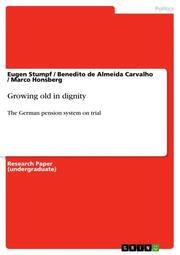Detailansicht
Growing old in dignity
The German pension system on trial
ISBN/EAN: 9783656049463
Umbreit-Nr.: 1375587
Sprache:
Englisch
Umfang: 48 S., 1 farbige Illustr.
Format in cm: 0.4 x 21 x 14.8
Einband:
kartoniertes Buch
Erschienen am 11.11.2011
Auflage: 3/2011
- Zusatztext
- Research Paper (undergraduate) from the year 2011 in the subject Politics - Political Systems - Germany, grade: 1,0, University of applied sciences, Düsseldorf, course: Economics - MBA, Master of Business Administration, language: English, abstract: This paper surveys the situation of the German pension system after a sequence of reforms which started as a fully funded system implemented by Bismarck during the 1880s, with a mandatory retirement age of 70 years when male life expectancy at birth was less than 45 years. Today, life expectancy for men is more than 80 years. After a long and arduous debate in the German Bundestag, agreements on a comprehensive pension reform resulted in the pension reform of 1957, which mainly established changes such as the normal retirement age at 65, the retirement at the age of 60 for elderly unemployed, the retirement for women at the age of 60 and, at last, the introduction of dynamic benefits indexed to gross wages which had an immediate impact on the economic wellness of current retirees. Thereafter, the 1972 reform made the German pension system one of the most generous of the world, as it mainly opened the public pension insurance system to all workers with generous terms for back-payment of contributions and eased the terms and conditions for early retirement by the implementation of the so-called flexible retirement, as discussed in chapter 1 of this paper. The following pension reforms discussed in this paper are the Riester reform of 2001 with the following main objectives: the sustainability of contribution rates in order to secure the longterm stability of pension levels and the spread of supplementary private pension savings, and continuing with the efforts of the Rürup commission which culminated in the Rürup reform of 2004 which the objective to stabilize contribution rates while at the same time ensuring appropriate future pension levels. Based on the above, it can be concluded that on the whole the sequence of pension reforms in Germany has successfully converted what was once a so called monolithic Bismarckian public insurance system to an efficient multi-pillar. Given this situation, as discussed in chapter 2 of this paper, the German pension system nowadays are based in a three-pillar system, consisting of the following elements: The first and most important pillar is universal and mandatory, organized as a pay-as-you-go system. The second pillar is the voluntary occupational pension system which is also universal and mandatory, but capital funded. The third pillar is also capital funded, but organized as a voluntary private provision system.
